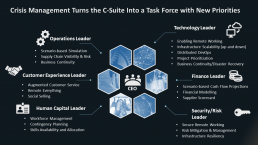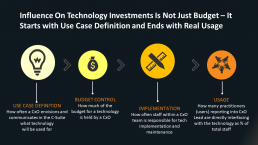In the 2020 crisis, volatility is forcing a frantic reshape of internal and external processes. 360 Degree Customer Management, automation of production plants, employee well-being analysis through machine learning – business use cases are taking center stage in the C-Suite. Almost 80% of European organizations dealt with Covid-19 with a C-Level taskforce, already in March.

The decision-making process for transformational technologies has never been more important – yet fragmented. It doesn’t have to be this way. The trick: CEOs should demand transparency on business programs and related technology investments and encourage systematic use-case discussions based on a “tug of value” motion.
IT Becoming One of Many Actors in Technology Decisions
CIO departments have been losing clout in technology purchase over the past decade. Line of business leaders such as the head of marketing, the chief financial officer or the human capital leader take on increasingly large amounts of investment on their own. We have heard this same old story since circa 2015. It is now undoubtedly true. CIOs in Europe will soon control less than 50% of the technology budget (Source: IDC Worldwide IT Spending Guide Line of Business, 2020). They were often caught flat-footed by business CxOs driving transformation projects in 2019 – with the current crisis forcing the hand on speed, they risk falling back to a cost manager position. Fast.
A lot of this change in the balance was driven by SaaS applications requiring few IT skills to use (at least on the surface) and little convincing for the CxO persona to buy. Some came from the infinite availability of developer resources in public cloud environments.
This is very quickly moving beyond cloud though, and spilling over into emerging technologies such as AI, IoT and 5G. For example, the head of operations of a global manufacturer in Germany is piloting Edge and 5G tech to support a smart factory scenario. Use cases included coordination of GPS-enabled autonomous vehicles to move materials across campus and on-stream, at Edge analysis of images from a laser-device measurement machine. He has a collaboration thread open with his CIO counterpart, but he remains fully in charge of those technologies.
Enter the Use Case “Tug of War”
In C-Suites where the CIO has a seat at the table, a tug of war on technology is often underway. On one level, it is about who controls the budget, the headcounts, and the implementation of those techs — numbers don’t lie. But this is not the most interesting angle. The all-important question is: who defines the business use case for those technologies? Who can identify in which processes or business tasks technology can make a difference?
The way we at IDC see it, budget, relevance, and position of power within the C-Suite increasingly depend on how good staff and leadership in that function are at use cases. This includes vision (i.e., imagining use cases) but also implementation through building or buying the technology.

Advanced organizations are already entering this phase of business-focused experimentation. The risk? This can easily become a “tug of war” between the CIO and head of digital or the CIO and the line of business lead where the use case will play out.
There are various ways the “tug of war” can go wrong. Here are some examples from conversations we have had with European buyers in recent months:
- The private equity department in a financial institution identified contract management as a use case for Blockchain went to external consultants without any IT involvement
- A chief digital officer was installed at a B2C company and the first thing he did was “hoarding ecommerce use cases, to deploy them in isolation from the sales and IT divisions”
- A CIO-cum-CISO regularly blocks use case ideas from other C-Suite members on dubious security reasons, without offering potential solutions
Make it a “Tug of Value”
Vertical and horizontal use cases, or well-defined business problems looking for a tech solution, are the best blueprint for innovative interactions within the C-Suite. Fighting over who controls those initiatives can easily derail transformation projects. If you are in a business or IT leadership position, you might want to:
- Take a step back and breathe — all of you folks are pulling in the same direction. You are not sure that is the case? Time to ask yourself hard questions about your organization.
- Encourage your CEO to set a good example by demanding transparency on business programs and their technology consequences — information should filter at least a couple of levels below C-Suite
- Create a “tug of value” motion — engage in “give and take” with your counterparts on use cases. If you notice divisions that are static and not identifying areas of innovation, reach out with use-case ideas in joint processes. If, on the other hand, the counterpart is full of initiatives, take them in and work out the implementation details with them. Mastering the “wavy motion” is important for all, but life-critical for CIOs if they want to remain relevant.
Over the five stages in the road to the Next Normal, C-Suites will live and die on their ability to visualize IT relevance for specific business problems and master its implementation. Tugging and nudging both ways is good — no need to bring your peers to their knees!
For more information, please reach out and follow us on social media IDC EMEA https://twitter.com/IDC_EMEA IDC CI&A https://www.idc.com/promo/customerinsights?tab=topic-one and Giorgio Nebuloni https://twitter.com/gnebuloni

